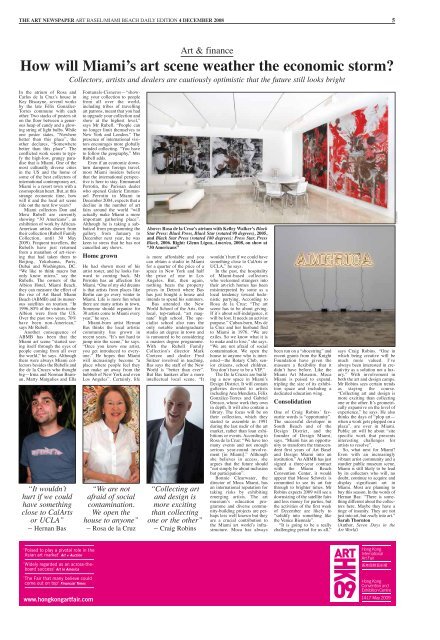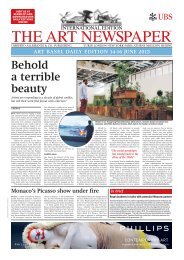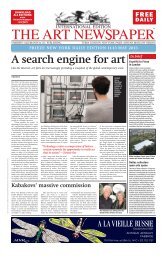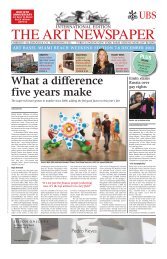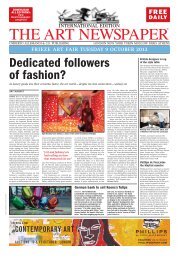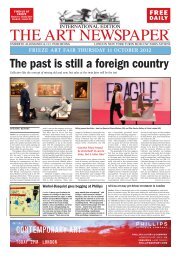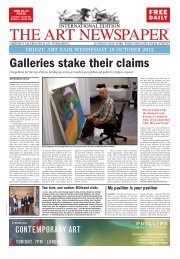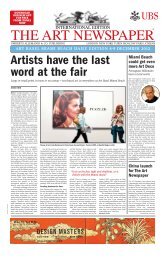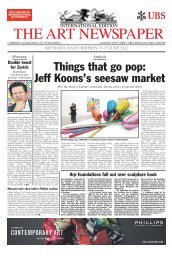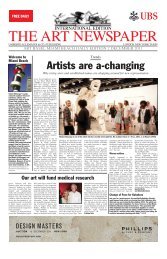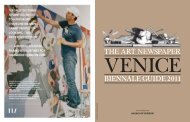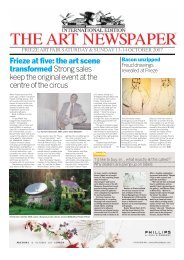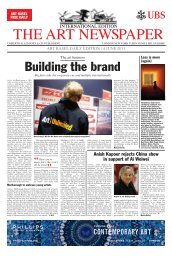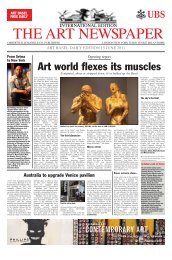Loyal buyers secure a positive start - The Art Newspaper
Loyal buyers secure a positive start - The Art Newspaper
Loyal buyers secure a positive start - The Art Newspaper
Create successful ePaper yourself
Turn your PDF publications into a flip-book with our unique Google optimized e-Paper software.
THE ART NEWSPAPER ART BASEL/MIAMI BEACH DAILY EDITION 4 DECEMBER 2008 5<br />
<strong>Art</strong> & finance<br />
How will Miami’s art scene weather the economic storm?<br />
Collectors, artists and dealers are cautiously optimistic that the future still looks bright<br />
In the atrium of Rosa and<br />
Carlos de la Cruz’s house in<br />
Key Biscayne, several works<br />
by the late Félix González-<br />
Torres commune with each<br />
other. Two stacks of posters sit<br />
on the floor between a generous<br />
heap of candy and a glowing<br />
string of light bulbs. While<br />
one poster states, “Nowhere<br />
better than this place”, the<br />
other declares, “Somewhere<br />
better than this place”. <strong>The</strong><br />
conflicted work seems to typify<br />
the high-low, grungy paradise<br />
that is Miami. One of the<br />
most culturally diverse cities<br />
in the US and the home of<br />
some of the best collectors of<br />
international contemporary art,<br />
Miami is a resort town with a<br />
cosmopolitan heart. But, at this<br />
strange economic time, how<br />
will it and the local art scene<br />
ride out the next few years?<br />
Miami collectors Don and<br />
Mera Rubell are currently<br />
showing “30 Americans”, an<br />
exhibition of work by African-<br />
American artists drawn from<br />
their collection (Rubell Family<br />
Collection, until 30 May<br />
2009). Frequent travellers, the<br />
Rubells have just returned<br />
from a marathon of art-viewing<br />
that had taken them to<br />
Beijing, Yokohama, Paris,<br />
Dubai and Washington, DC.<br />
“We like to think macro but<br />
only know micro,” say the<br />
Rubells. <strong>The</strong> owners of the<br />
Albion Hotel, Miami Beach,<br />
they can measure the effect of<br />
the rise of <strong>Art</strong> Basel Miami<br />
Beach (ABMB) and its numerous<br />
satellites on tourism. “In<br />
1996, 80% of the visitors to the<br />
Albion were from the US.<br />
Over the past two years, 70%<br />
have been non-American,”<br />
says Mr Rubell.<br />
Another consequence of<br />
ABMB has been that the<br />
Miami art scene “<strong>start</strong>ed seeing<br />
itself through the eyes of<br />
people coming from all over<br />
the world,” he says. Although<br />
there were always Miami collectors<br />
besides the Rubells and<br />
the de la Cruzes who thought<br />
big—Irma and Norman Braman,<br />
Marty Margulies and Ella<br />
“It wouldn’t<br />
hurt if we could<br />
have something<br />
close to Cal<strong>Art</strong>s<br />
or UCLA”<br />
– Hernan Bas<br />
'<br />
'<br />
'<br />
Fontanals-Cisneros—“showing<br />
your collection to people<br />
from all over the world,<br />
including tribes of travelling<br />
art patrons, meant that you had<br />
to upgrade your collection and<br />
show at the highest level,”<br />
says Mr Rubell. “People can<br />
no longer limit themselves to<br />
New York and London.” <strong>The</strong><br />
presence of international visitors<br />
encourages more globally<br />
minded collecting. “You have<br />
to follow the geography,” Mrs<br />
Rubell adds.<br />
Even if an economic downturn<br />
dampens foreign travel,<br />
most Miami insiders believe<br />
that the international perspective<br />
is here to stay. Emmanuel<br />
Perrotin, the Parisian dealer<br />
who opened Galerie Emmanuel<br />
Perrotin in Miami in<br />
December 2004, expects that a<br />
decline in the number of art<br />
fairs around the world “will<br />
actually make Miami a more<br />
important gathering place”.<br />
Although he is taking a sabbatical<br />
from programming the<br />
gallery from January to<br />
December next year, he was<br />
keen to stress that he has not<br />
cancelled any shows.<br />
Home grown<br />
He had shown most of his<br />
artist roster, and he looks forward<br />
to coming back. Mr<br />
Perrotin has an affection for<br />
Miami. “One of my old dreams<br />
is that artists from places like<br />
Berlin can go every winter to<br />
Miami. Life is more fun when<br />
there are many artists in town.<br />
Someone should organise for<br />
30 artists come to Miami every<br />
year,” he says.<br />
Miami-born artist Hernan<br />
Bas thinks the local artistic<br />
community has grown in<br />
recent years. “It’s not hard to<br />
jump into the scene,” he says.<br />
“Once you know one artist,<br />
you get introduced to everyone.”<br />
He hopes that Miami<br />
will increasingly become “a<br />
place where people feel they<br />
can make art away from the<br />
hubbub of New York and even<br />
Los Angeles”. Certainly, life<br />
“We are not<br />
afraid of social<br />
contamination.<br />
We open the<br />
house to anyone”<br />
– Rosa de la Cruz<br />
Above: Rosa de la Cruz’s atrium with Kelley Walker’s Black<br />
Star Press: Black Press, Black Star (rotated 90 degrees), 2005,<br />
and Black Star Press (rotated 180 degrees): Press Star, Press<br />
Black, 2006. Right: Glenn Ligon, America, 2008, on show at<br />
“30 Americans”<br />
is more affordable and you<br />
can obtain a studio in Miami<br />
for a quarter of the price of a<br />
space in New York and half<br />
the price of one in Los<br />
Angeles. But, then again,<br />
nothing beats the property<br />
prices in Detroit where Bas<br />
has just bought a house and<br />
intends to spend his summers.<br />
Bas attended the New<br />
World School of the <strong>Art</strong>s, the<br />
local, top-ranked, “art magnate”<br />
high school. <strong>The</strong> specialist<br />
school also runs the<br />
only notable undergraduate<br />
studio art degree in town and<br />
is rumoured to be considering<br />
a masters degree programme.<br />
With the Rubell Family<br />
Collection’s director Mark<br />
Coetzee and dealer Fred<br />
Snitzer involved in teaching,<br />
Bas says the staff of the New<br />
World is “better than ever”.<br />
But Bas hankers after a more<br />
intellectual local scene. “It<br />
“Collecting art<br />
and design is<br />
more exciting<br />
than collecting<br />
one or the other”<br />
– Craig Robins<br />
wouldn’t hurt if we could have<br />
something close to Cal<strong>Art</strong>s or<br />
UCLA,” he says.<br />
In the past, the hospitality<br />
of Miami-based collectors<br />
who welcomed strangers into<br />
their art-rich homes has been<br />
misinterpreted by some as a<br />
local tendency toward hedonistic<br />
partying. According to<br />
Rosa de la Cruz: “<strong>The</strong> art<br />
scene has to be about giving.<br />
If it’s about self-indulgence, it<br />
will be lost. It needs an activist<br />
purpose.” Cuban-born, Mrs de<br />
la Cruz and her husband fled<br />
to Miami in 1976. “We are<br />
exiles. So we know what it is<br />
to make and to lose,” she says.<br />
“We are not afraid of social<br />
contamination. We open the<br />
house to anyone who is interested—the<br />
Rotary Club, senior<br />
citizens, school children.<br />
You don’t have to be a VIP.”<br />
<strong>The</strong> De la Cruzes are building<br />
a new space in Miami’s<br />
Design District. It will contain<br />
galleries devoted to artists<br />
including Ana Mendieta, Félix<br />
González-Torres and Gabriel<br />
Orozco, whose work they own<br />
in depth. It will also contain a<br />
library. <strong>The</strong> focus will be on<br />
their collection, which they<br />
<strong>start</strong>ed to assemble in 1991<br />
during the last nadir of the art<br />
market, rather than loan exhibitions<br />
or events. According to<br />
Rosa de la Cruz: “We have too<br />
many events and not enough<br />
serious year-round involvement<br />
[in Miami].” Although<br />
she believes in access, she<br />
argues that the future should<br />
“not simply be about inclusion<br />
but participation”.<br />
Bonnie Clearwater, the<br />
director of Moca Miami, has<br />
an international reputation for<br />
taking risks by exhibiting<br />
emerging artists. <strong>The</strong> art<br />
museum’s education programme<br />
and diverse community-building<br />
projects are perhaps<br />
less well known but they<br />
are a crucial contribution to<br />
the Miami art world’s infrastructure.<br />
Moca has always<br />
been run on a “shoestring” and<br />
recent grants from the Knight<br />
Foundation have given the<br />
museum a flexibility that it<br />
didn’t have before. Like the<br />
Miami <strong>Art</strong> Museum, Moca<br />
Miami is poised to expand,<br />
tripling the size of its exhibition<br />
space and including a<br />
dedicated education wing.<br />
Consolidation<br />
One of Craig Robins’ favourite<br />
words is “opportunity”.<br />
<strong>The</strong> successful developer in<br />
South Beach and of the<br />
Design District, and the<br />
founder of Design Miami,<br />
says, “Miami has an opportunity<br />
to transform the transcendent<br />
first years of <strong>Art</strong> Basel<br />
and Design Miami into an<br />
institution.” As ABMB has just<br />
signed a three-year contract<br />
with the Miami Beach<br />
Convention Center, it would<br />
appear that Messe Schweiz is<br />
committed to see its art fair<br />
through to brighter times. Mr<br />
Robins expects 2009 will see a<br />
downsizing of the satellite fairs<br />
and less money for parties, but<br />
the activities of the first week<br />
of December are likely to<br />
“solidify into something like<br />
the Venice Biennale”.<br />
“It is going to be a really<br />
challenging period for us all,”<br />
says Craig Robins. “One in<br />
which being creative will be<br />
much more valued. I’ve<br />
always been interested in creativity<br />
as a solution not a luxury.”<br />
With involvement in<br />
both the art and design camps,<br />
Mr Robins sees certain trends<br />
as staying the course.<br />
“Collecting art and design is<br />
more exciting than collecting<br />
one or the other. It’s geometrically<br />
expansive on the level of<br />
experience,” he says. He also<br />
thinks the days of “plop art—<br />
when a work gets plopped on a<br />
plaza”, are over in Miami.<br />
Public art will be about “site<br />
specific work that presents<br />
interesting challenges for<br />
artists to resolve”.<br />
So, what next for Miami?<br />
Even with an increasingly<br />
vibrant artist community and a<br />
sturdier public museum scene,<br />
Miami is still likely to be lead<br />
by its collectors who will, no<br />
doubt, continue to acquire and<br />
display significant art in<br />
Miami. Most are planning to<br />
buy this season. In the words of<br />
Hernan Bas: “<strong>The</strong>re is something<br />
different about the collectors<br />
here. Maybe they have a<br />
tinge of insanity. <strong>The</strong>y are not<br />
just into art, but really into art.”<br />
Sarah Thornton<br />
(Author, Seven Days in the<br />
<strong>Art</strong> World)<br />
C.M. GUERRERO


